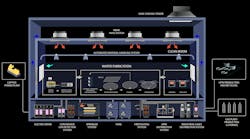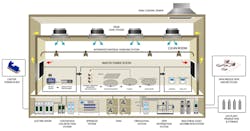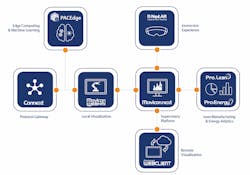Semiconductor foundries are built and run with large capital and operational expenditures. More than $700 billion is earmarked globally for capital expenditure over the next five years. Industries including automotive, electronic consumer goods, machine manufacturing and defense production are heavily dependent on the products made by these foundries. Disruptions in semiconductor production over the past few years triggered cascading effects on other industries and greatly impacted the global macroeconomics.
The competitive manufacturing operations rely on maximized availability, minimized underutilization and optimized major utility costs. Closely integrated monitoring and control technologies are needed to achieve these goals. However, manufacturers are discovering that the right edge technologies must be in place to fully support these efforts.
READ MORE: The Semiconductor Race is On!
Most of the wafer fabrication equipment, and many parts of the support systems, are procured as OEM machines and systems. Integrating this OEM equipment with utility distribution and facility environmental controls on one or more systems built on site can be very challenging. The secure use of Industrial Internet of Things (IIoT) technologies to conveniently access information from anywhere further complicates the process.
Design engineers looking to address these issues should consider applying specific edge-oriented hardware running a range of visualization, automation, IIoT and analytical software. These edge solutions are needed to monitor and coordinate a variety of production and balance-of-plant (BOP) systems to ensure optimal foundry performance.
Data and Control for Optimized Management
Connectivity supporting optimized foundry management with the BOP must be a two-way street, combining responsive data access (read) with the ability to issue real-time control commands (write). Achieving this connectivity is a challenge, in part because of the many different systems and control platforms implemented at a site (Fig. 1):
- Fabrication machinery
- Ultrapure water generation
- Gas distribution and detection
- Electrical control and monitoring systems
- Heating/ventilation/air conditioning
- HEPA filtration and clean room monitoring
- Fire detection and control
- Laboratory information monitoring systems
- Continuous emissions monitoring systems
Integrated control must incorporate a multitude of capabilities to interact with many unique systems, including edge computing and cloud resources for processing of large historical data sets. The inevitable evolution of foundry digital transformation and the associated increased connectivity makes it imperative for edge solutions to incorporate robust cybersecurity to resist breaches that can affect production, create safety concerns and/or create the possibility for data theft or loss.
The 24/7 operating nature of semiconductor foundries means that any associated edge solutions also must be up to the task of running non-stop. High availability technologies, particularly in the form of redundancy for controllers and networks, is a typical approach.
Edge Technologies Meet Challenges
It may be tempting to consider hobbyist microcontrollers and office-grade computing hardware for use at the edge, but these products simply are not built robustly enough to withstand a foundry’s environmental conditions. Furthermore, this approach requires users to mix-and-match all sorts of hardware and software to meet their objectives. This introduces excessive integration risks, lowers solution reliability and requires users to expend significant effort for design, interoperability testing, security evaluations, commissioning and ongoing operational support.
A better method is to develop foundry and BOP integration platforms built on a platform of hardware and software technologies designed for the field environment, with specific functionality, connectivity and security tailored for the tasks (Fig. 2).
Deterministic control. Modern programmable logic controllers (PLCs) and programmable automation controllers (PACs) are the proven way for directly controlling equipment, and they can fulfill some edge data gathering roles.
Edge control and computing. Newly available edge controllers combine the deterministic functionality of PLCs/PACs with general-purpose computing for connecting with edge data, pre-processing it, making it available for analytics, supporting visualization, initiating closed-loop control and performing other IIoT tasks.
Edge connectivity, computing and HMI/SCADA. For more intensive gateway communications and analytical calculations, as well as for hosting human-machine interfaces and SCADA systems, industrial PCs are the platform of choice.
Edge enablement software. There are many open software applications promoting themselves for edge solutions and IIoT projects. Users are looking for a curated suite of these applications, organized so they can quickly and reliably create data communication, analytical and other IIoT solutions. User must also look for software which integrates real time PLC/PAC operating systems via a secured communication link.
HMI/SCADA software. Similarly, users find it most convenient to choose HMI/SCADA software where one toolset can be used to create data access and visualization solutions ranging from small HMI instances to large SCADA systems, and then deploy these to a full range of mobile, industrial and PC targets.
Analytics software. Instead of programming analytics from the ground up, industrial users can take advantage of modules addressing common manufacturing needs such as overall equipment effectiveness, key performance indicators and energy consumption optimization.
Some suppliers have recognized end-user needs for obtaining coordinated edge platforms supporting all these roles, and they have responded by creating optimized combinations of hardware and software. Designers can select one or more best-fit options and build their solutions incrementally from the edge upward—confident in the compatibility, scalability and security of the underlying elements—and selecting high availability options for critical applications.
Edge in Action
Reliable edge solutions allow users focus their efforts on addressing availability, underutilization and utility costs, rather than spending time researching and experimenting with platforms.
Availability. With data handling systems, it may be acceptable to experience infrequent and brief outages. But in general, all industrial processes and controls require maximum uptime to prevent production losses and delays. For these cases, users should consider scalable PLC/PAC and edge controller hardware platforms—with redundancy configurable using just a few software checkboxes—and fast switchover times to ensure uninterrupted control and monitoring of applications and processes with total transparency.
These systems must also provide built-in security protocols and a broad suite of cybersecurity technologies and tools. The communication between controllers must be tokenized and encrypted, ensuring commands are accepted only from authorized users.
Not all high availability options are implemented in the same way. Only some implementations allow hardware replacement with differing firmware revisions—and software upgrades, patches and antivirus updates with zero downtime. Furthermore, users should look for implementations that use industrial networking protocols like PROFINET and OPC UA, which support high availability and provide the best way to obtain a unified view of all instruments, equipment and devices.
Underutilization. Only by measuring and analyzing source information can foundry engineers determine if all systems are being fully utilized. Some analytics are appropriate at the cloud level, so long as provisions are considered for data fidelity and latency. However, in many cases the preferred choice is to execute certain data analytics algorithms right at the edge using historical and real-time data, and to then communicate this pre-processed information to the cloud for deeper analysis. This approach lets users respond rapidly onsite to changing conditions, while using near-infinite cloud resources for the most complex calculations.
Predictive diagnostics coupled with an alarm dispatcher function, all running on a complete edge solution, ensures that equipment deterioration is detected early, with operators and maintenance personnel notified wherever they are. This allows for proactive and scheduled maintenance, which reduces unexpected downtimes that can idle entire production lines.
Edge-sourced data is also needed so users can improve manufacturing output while minimizing waste. If implemented the right way, a robust solution guarantees an enhanced OEE by ensuring higher utilization and availability.
Utility costs. A semiconductor foundry is extremely power intensive, with 40% of total power consumed by fabrication machines, and the rest used by BOP processes. As the technology for producing smaller nm-format chips evolves, the power usage significantly increases, so there is a strong need to develop an infrastructure enabling energy consumption optimization across processes.
For example, by comparing all machines of a given type—lithography, etching, chemical mechanical planarization, etc.—a manufacturer can evaluate energy consumption per unit of output. Once these KPIs are baselined, foundry engineers can detect OEE deterioration across various makes/models and entire fleets of equipment.
Comparative analytics can be run across foundries located globally and various insights around operational excellence can be derived and replicated across sites. Documented evidence helps foundry engineers communicate better with machine OEMs for service or defect escalation. Similarly, BOP process monitoring, like energy consumed per gallon of ultrapure water production, gas consumption and water recycling metrics, can identify the most important opportunities for cost reduction for each of these utility processes.
Improving Availability, Efficiency
A highly integrated semiconductor foundry is essential to execute the complicated manufacturing processes for flawlessly turning silicon into complex chips. Suboptimal performance of any critical element of the process will lead to higher rejection rates, process breakdown and manufacturing line resets/restarts. It will also increase the recall rates of the manufacturer.
It is therefore imperative that foundry subsystems perform in an integrated way to improve availability, minimize underutilization, and optimize energy usage. This integration involves not just reading data, but also processing it and creating active control responses to maximize output, efficiency and the overall OEE of the entire operation.
The path to creating this integration infrastructure is simplified by using powerful and secure edge solutions, built with hardware and software specifically oriented for the connectivity, performance and security needs of the industrial environment. Edge solution costs are negligible compared to the possible CAPEX underutilization and OPEX losses resulting from a suboptimal foundry system infrastructure, making them a wise investment.
Manish Sharma is a marketing leader for Emerson’s Machine Automations Solutions business and is responsible for its portfolio targeting the semiconductors, energy and water markets. He has 20 years of experience in marketing, product management and control systems R&D, and holds three U.S. patents for control systems solutions.



